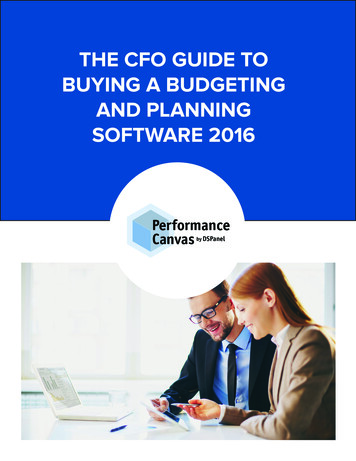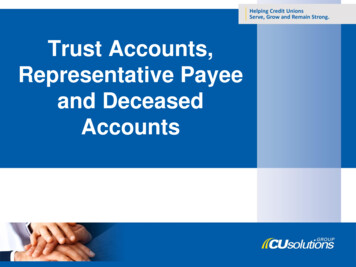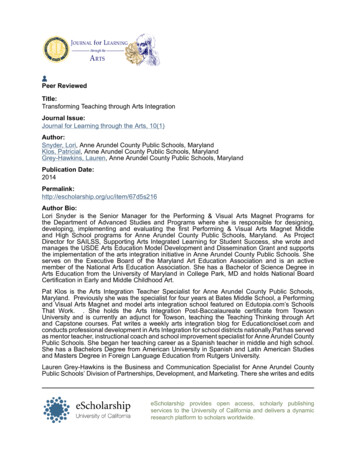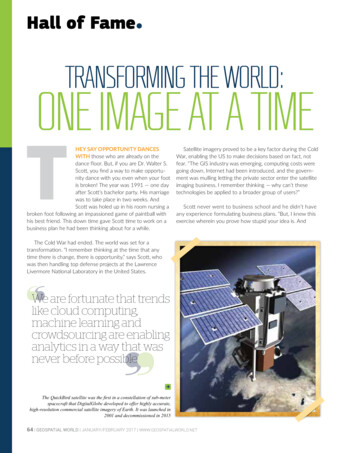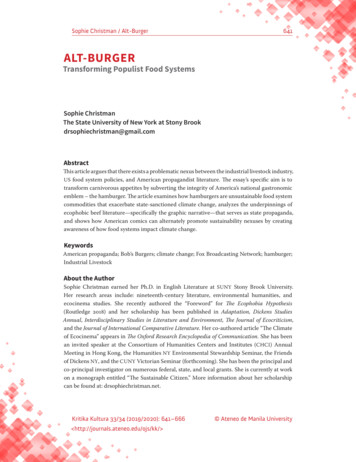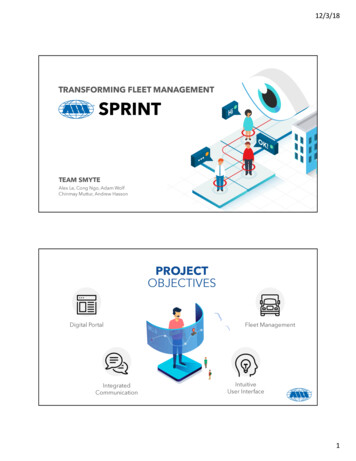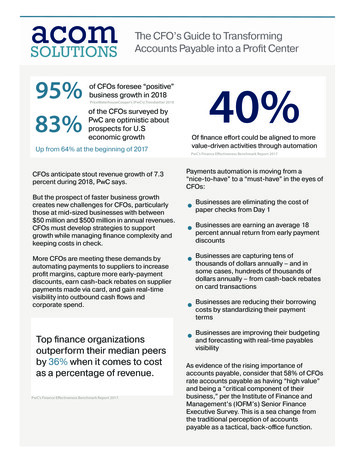
Transcription
The CFO’s Guide to TransformingAccounts Payable into a Profit Center95%83%of CFOs foresee “positive”business growth in 2018PriceWaterhouseCooper’s (PwC’s) Trendsetter 2018of the CFOs surveyed byPwC are optimistic aboutprospects for U.Seconomic growthUp from 64% at the beginning of 2017CFOs anticipate stout revenue growth of 7.3percent during 2018, PwC says.But the prospect of faster business growthcreates new challenges for CFOs, particularlythose at mid-sized businesses with between 50 million and 500 million in annual revenues.CFOs must develop strategies to supportgrowth while managing finance complexity andkeeping costs in check.More CFOs are meeting these demands byautomating payments to suppliers to increaseprofit margins, capture more early-paymentdiscounts, earn cash-back rebates on supplierpayments made via card, and gain real-timevisibility into outbound cash flows andcorporate spend.Top finance organizationsoutperform their median peersby 36% when it comes to costas a percentage of revenue.PwC’s Finance Effectiveness Benchmark Report 2017.40%Of finance effort could be aligned to morevalue-driven activities through automationPwC’s Finance Effectiveness Benchmark Report 2017Payments automation is moving from a“nice-to-have” to a “must-have” in the eyes ofCFOs:Businesses are eliminating the cost ofpaper checks from Day 1Businesses are earning an average 18percent annual return from early paymentdiscountsBusinesses are capturing tens ofthousands of dollars annually – and insome cases, hundreds of thousands ofdollars annually – from cash-back rebateson card transactionsBusinesses are reducing their borrowingcosts by standardizing their paymenttermsBusinesses are improving their budgetingand forecasting with real-time payablesvisibilityAs evidence of the rising importance ofaccounts payable, consider that 58% of CFOsrate accounts payable as having “high value”and being a “critical component of theirbusiness,” per the Institute of Finance andManagement’s (IOFM’s) Senior FinanceExecutive Survey. This is a sea change fromthe traditional perception of accountspayable as a tactical, back-office function.
White Paper Acom SolutionsThe CFO’s Guide to Transforming Accounts Payable into a Profit CenterThirty-Three Percentof finance executives surveyed by CFOResearch said their business increased netincome and profit margins because ofautomating financial processes.This white paper provides CFOs with a guide fortransforming accounts payable into a profitcenter.Cash is KingEffectively managing outbound cash flows iscritical to supporting business growth.Accounts payable automation is keyto helping CFOs deliver on theirmandate to optimize financial assetsand liabilities, drive cash flowimprovements, and managefinancial risk.Outbound cash flows impact capitalexpenditures, strategic decisions, andborrowing.So, it is not surprising that the cash flowagainst current and future expenses tops the listof financial metrics tracked by businesses, perIOFM's Finance Executive Survey.Even more telling is that CFOs rank cash flowanalysis and liquidity management as their topjob priority. A cash flow analysis providesbusinesses with visibility into their assuredincome, irrespective of market or economicconditions. Effective cash management ensurestimely payments, eliminates late fees, increasesinvestable income and return-ratios, andreduces the needfor borrowing and corporatedebt.71%of CFOs say that their organization considersgrowth to be a strategic priority, perAccenture.CFOs must harness the collective ability of theentire finance organization to optimize cashflows to help their business grow. The stakesare high in today’s competitive global economywith disruptive competitors.One of the largest opportunities to impactcash flow lies within supplier payments.The Changing Role of AccountsPayableAccounts payable has historically beenviewed as a cost center.As recently as 2016, one-third of businessesconsidered their accounts payable function asvaluable in the context of processing invoices,scheduling supplier payments, and mailingchecks, but not strategic, per Ardent Partners’ePayables: Eyes on the Prize report.One-third of businesses viewed accountspayable as valuable only at the project level,collaborating occasionally with partners.
White Paper Acom SolutionsThe CFO’s Guide to Transforming Accounts Payable into a Profit CenterTransforming Accounts Payableinto a Profit CenterBusinesses of all sizes are embracingelectronic payments to suppliers.There are four steps that CFOs at mid-sizedbusinesses with between 50 million and 500million in annual revenues can take to transformtheir accounts payable department into a profitcenter.Automated Clearing House (ACH)transactions represent nearly 33 percent ofall payments to suppliers while wire transferaccounts for nine percent of payments,according to IOFM’s researchStep #1: Pay Suppliers ElectronicallyThe first step to transforming accounts payableinto a profit center is to pay supplierselectronically.Virtual cards represent five percent of allpayments to suppliers – a huge increase overjust a few years ago when cards were primarilyused for small-dollar purchases and businesstravel expenses.In a traditional check payments environment,staff must print, sign, and mail paper checksto suppliers or log in to one of potentiallyseveral bank portals to initiate electronictransactions. Managing multiple paymentsystems inevitably results in higher overheadand banking fees. Making matters worse, mostbusinesses must add staff as their paymentsvolume increases.And manually reconciling supplier checkpayments is a time-consuming and errorprone process.Not surprisingly, 63 percent of businesses citethe operational costs around the reconciliationof invoices and payments as a major painpoint, per IOFM. Lost and stolen checkscontribute to paper checks being 10 timesmore prone to fraud than electronictransactions, per IOFM. Additionally, payingsuppliers with paper checks also offers noopportunities to earn cash-back rebates.Automated electronicpayment processes cost60% less on average thantheir manual paper-basedcounterparts.Ardent Partners 2016-2017 Technology and Innovation Outlook ReportThe use of electronic payments has grown a lotsince 2013, when businesses made 71 percentof their payments via paper check, per IOFM’sAP Department Benchmark and Analysis report.For instance, accounts payable departmentshave replaced an average of 11 percent of theirinvoice volume with purchasing cardtransactions. What’s more, nearly threequarters of businesses have a strategy in placeto increase their percentage of electronicpayments to suppliers IOFM finds.Electronic payments are a strong foundation forworking capital optimization initiatives.For starters, some providers of electronicpayment solutions eliminate the costsassociated with paying suppliers from Day 1.Electronic payments also streamline paymentoperations. A single payment file uploadinitiates payment to all buyer’s suppliers;instructions are parsed, and payments areautomatically remitted in all payment methods.This eliminates the need to log in to multiplebanking systems and wipes out the costs ofprinting and mailing paper checks. What’smore, integrating electronic payments with thegeneral ledger of an ERP platform providesreal-time payment reconciliation that eliminatesthe keying of data or the decoding of bankingmessages.
White Paper Acom SolutionsThe CFO’s Guide to Transforming Accounts Payable into a Profit CenterAdditionally, advanced solutions automaticallytrack approved and initiated payments and anyrejects, with detailed payment and reconciliationreports integrated into the buyer’s ERP system.This end-to-end tracking enables more accurateaccrual reporting, greater payment reportingintegrity, and better visibility into spendingbased on the metrics most important to the CFOBest-in-class accountspayable teams spend 92%less per supplier payment thantheir peersArdent Partners 2016-2017 Technology and Innovation Outlook ReportStep #2: Enhance Visibility into OutboundCashflowThe second step to transforming accountspayable into a profit center is to enhancevisibilityAccounts payable data is often the ‘eyes’ to thefinancial soul of the business, since CFOs andother finance executives can use it to gaininsight into corporate financial health, notesAndrew Bartolini, chief research officer atArdent Partners. “The spend- and supplierspecific data included in invoices can beleveraged to identify spend trends andpatterns, support future supplier negotiations,and can determine how well-positioned acompany is to take advantage of supply chainfinancing options.”Accounts payable departments have anopportunity to serve as an information hub toCFOs by providing critical insights into cashflows, corporate spending, and operationsperformance.But in a manual accounts payable environment,key information is not captured, systems arefragmented, information is not timely, anddecision-makers do not have access to keyvariables.Seventeen percent of CFOs saythat difficulty capturing earlypayment discounts is theirbiggest accounts payablechallengeIOFM’s Senior Finance Executive Survey reports.Paper-based processes also provideinadequate visibility into spending. Finance oftendoes not know about an invoice until it shows upon their desk. This is a big reason why 22percent of businesses can only forecast mid-termcash flow with five percent accuracy, according toindustry benchmarks. The inability to plan forlarge amounts of spending can have rippleeffects across the business.Step #3: Accelerate Cycle TimesThe third step towards transformingaccounts payable into a profit center is to.accelerate invoice approval cycle times tocreate more opportunities to capture earlypayment discounts from suppliers.Eighty percent of suppliers are willing toexchange discounts on the amount due on aninvoice in exchange for early payment, IOFMreports. The earlier the payment, the largerthe discount.The savings from early payment discounts addup – more than offsetting accounts payableoverhead.There are two primary ways that accountspayable departments can capture earlypayment discounts:
White Paper Acom SolutionsThe CFO’s Guide to Transforming Accounts Payable into a Profit Center1.Dynamic discounting: this is when anearly payment is made to a supplierusing the buyer’s balance sheet cash (thebuyer must have cash in reserve to make theearly payment). Here’s how dynamicdiscounting works: a supplier sends an invoiceto a buyer; the buyer approves the invoice; thesupplier receives an early payment discountoffer from the buyer; if the offer is accepted,the buyer adjusts the invoice to reflect thediscount and executes the payment.That means that a 1 billion-revenuecompany that previously captured 200,000annually in early payment discounts may gain 1.4 million a year in additional discountsthrough automation.Capturing early payment discounts can makea major financial contribution to businessgrowth.2.Supply chain financing: this is when anearly payment is made using cash froma third-party, such as a bank, financialinstitution or investment firm. As with dynamicdiscounting, a supplier sends an invoice to abuyer; the buyer approves the invoice; thebuyer and the supplier negotiate early paymentdiscount terms; once the terms of the earlypayment are negotiated, the third-party takeson the risk and pays the supplier; when theinvoice reaches maturity, the buyer pays the fullinvoice value to the third-party.Supply chain financing enables buyers tomake an early payment when balance sheetcash is unavailable.The savings from early payment discountscan potentially deliver eight times the financialbenefit of savings from invoice processingautomation alone, IOFM’s benchmarkingresearch shows.Let’s put that into perspective:Highly automated accounts payabledepartments capture seven times moreearly-payment discounts (as a percentageof spend) as their peers, per The HackettGroup’s E-Invoicing Benchmarking Study.Sixty-Six Percentof CFOs lack visibility into keyinsight areas.Accenture reports
White Paper Acom SolutionsThe CFO’s Guide to Transforming Accounts Payable into a Profit CenterAbout 60 percent of financeoperations rely on spreadsheetsfor reporting.Additionally, in a manual accounts payableenvironment, cost-center managers may nothave real-time visibility into their business unit’sspending. Accounts payable leaders do nothave visibility into the status of invoices andpayments, or the root cause of exceptions. Andfinancial and procurement leaders cannoteasily access the reports required for decisionmaking.ERP systems don’t offer much help. Buildingreports in an ERP system, or with a standalonebusiness intelligence platform is verycomplicated, typically involving complexdatabase queries.Advanced payment solutions provide CFOs withactionable cash flow insights such as:On-time payment percentageSpend visibility and trendsSpend-to-supplier ratioAccounts payable value and volumesAccounts payable process metricsPayment and discount capture metricsTeam productivity metricsThirty-seven percentof businesses surveyed by CFOResearch cited better budgetingand forecasting as one of the topbenefits of automating theirfinancial operations.Forty-five percentof senior finance executives saythat a lack of visibility into payablesinformation is their biggestaccounts payable challenge,per IOFM.Sixty-eight percentof controllers identified improvingvisibility into cash flow as the mostcritical finance and administrationpriority, per IOFM's Senior FinanceExecutive Survey.Automation also tracks the status of payments(including initiated payments and rejects),generating detailed transaction andreconciliation reports, providing a consolidatedview of all payout accounts. All this enablesmore accurate accrual reporting and greaterreporting integrity, which supports profitability.A digital environment where theCFO makes real-time financialdecisions utilizing real-timeinformation and customizabledashboards is within the reach ofmore businesses.
White Paper Acom SolutionsThe CFO’s Guide to Transforming Accounts Payable into a Profit CenterStep #4: Earn Cash-Back RebatesThe final step towards transforming accountspayable into a profit center is to capturecash-back rebates on payments made via avirtual card – plastic-less cards tied to a singletransaction.59%of supplier payments are initiatedelectronically, the Association forFinancial Professionals’Payments Benchmarking Surveyreports.Strategic Treasurer’s 2017 B2B Payments &Working Capital Survey illustrates the declinechecks:Paper checks are the least-preferredpayment option of best-in-classaccounts payable departments.Fifty-five percent of best-in-classaccounts payable departments makemore than half their supplier paymentselectronically.Fifty-four percent of best-in-classaccounts payable departments view ACHas their preferred payment methods.Forty-three percent of best-in-classaccounts payable departments regularlylook to earn cash-back rebates.The number of checks issued inthe United States declined by2.3 billion between 2012 and 2015,the U.S. Federal Reserve’sPayments Study finds.What really has CFOs at mid-sized businessesexcited about electronic payments is theopportunity to earn cash-back rebates onpayments made via virtual card. It is notuncommon for businesses to earn cash-backrebates on 30 percent of their spending. Insome cases, the cash-back rebates earned bybusinesses have single handedly transformedtheir accounts payable department a profitcenter.The money earned through cash-back rebatesand the other working capital strategiesdescribed in this white paper can provideCFOs with the money to automate invoiceprocessing.One real estate companyearned 800,000 in cashback rebates in one yearon virtual card transactions.
White Paper Acom SolutionsThe CFO’s Guide to Transforming Accounts Payable into a Profit CenterAn Action PlanTransforming accounts payable into a profit center through automation is no sure thing withoutthe right solution. CFOs should look for an accounts payable solution with the following attributes:Seamless ERP integration: achievingcomplete visibility into outbound cashflows requires a solution that seamlesslyuploads invoice data into any ERP oraccounting system.Intuitive dashboards: the real-timereporting in advanced accounts payablesolutions enables businesses to forecastoutbound cash flows with 98 percentaccuracy. And instant access to accountbalances enables CFOs to make betterdecisions about discount offersA single solution for any paymentmethod: not every supplier will acceptvirtual card payments. So, look for asolution that facilitates payments viacheck, virtual card or ACH using a singlepayment file, and offers cash-back rebatesfor payments made via virtual card.ConclusionThe role of the CFO is changing. Businessesexpect their CFO to drive corporate growthobjectives. Accounts payable can play a bigpart in helping the CFO achieve this objective,particularly those at mid-sized businesses withbetween 50 million and 500 million inrevenues. Automating with the right solutiontransforms accounts payable into a profitcenter through lower costs, faster cycletimes, enhanced visibility into outbound cashflows, and cash-back rebates on paymentsmade via card.ACOM SolutionsThis white paper was sponsored by ACOMSolutions.Since 1983, ACOM Solutions has deliveredautomated payment solutions that transformaccounts payable from a cost center into aprofit center.Our Accounts Payable electronic payments solutionsautomate paper-intensive processes, eliminate thecost of paying suppliers and vendors, increase APworking capital, generate revenue AP spend rebates,and mitigate payment fraud.Annually, ACOM processes 112 Billion in AccountsPayable spend, 96 million invoices, and 32 Millionpayment transactions.Our integration with more than 100 ERP andaccounting software systems – including thosefrom Microsoft Dynamics GP, Sage and Abila MIP –means you can automate the Accounts Payablepayment process without changing the way you work.We combine our electronic payment solutions withVendor Management Services that are proven todeliver optimum supplier adoption without creatingextra work for you.More than 1,500 clients across industries depend onour accounts payable solutions.Learn more at www.acom.com.
accounts payable, consider that 58% of CFOs rate accounts payable as having “high value” and being a “critical component of their business,” per the Institute of Finance and Management’s (IOFM’s) Senior Finance Executive Survey. This is a sea change from the traditional perception of acc
